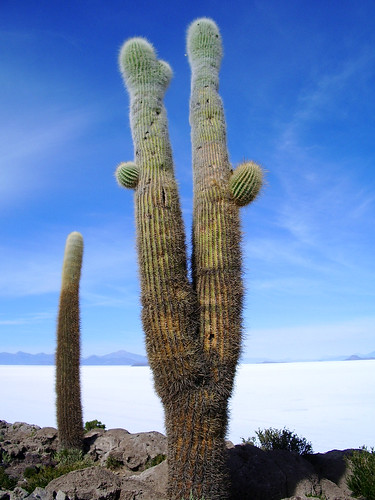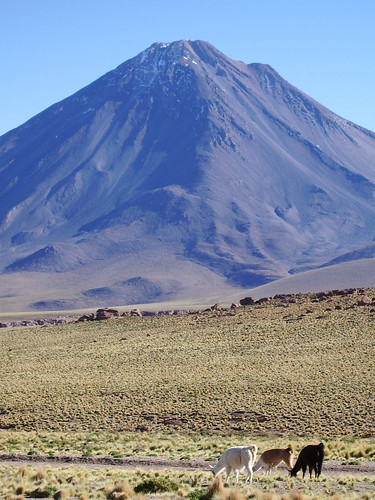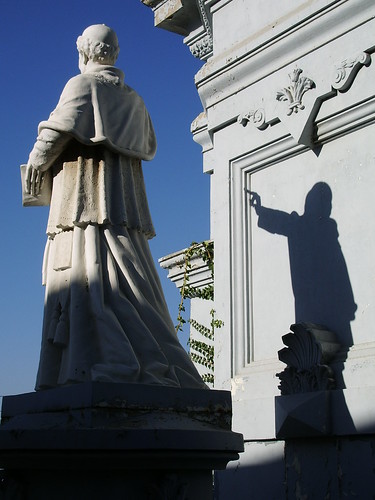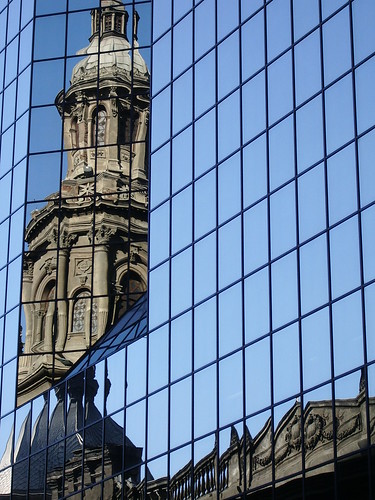See our photos from Rurrenabaque
A tiny, 12-seater plane swept us to the town of Rurrenabaque in the Amazon basin. The views were spectacular as we dodged the Andes mountain range and flew over dense jungle. Three guys at the front of the plane filmed the journey, unwittingly knocking the pilots headset off a few times with their camera lens.
Every gust of wind tossed the plane around and soon we were amidst thick cloud. How does the pilot know where the mountains are? Will we crash land in the jungle and end up eating each other, like in that film Alive? After 15 minutes of dense, milky mist, the pilot saw a break in the clouds and made a dive for it. We touched down on a field in the jungle. An old man raced out waving two fluorescent batons to direct the plane, but managed to drop one in the long grass. By the time he found it again we were climbing out of the plane. Seeing us standing on the grass, the plane motionless, he gave the sticks a little wave anyway.
The airport was a shack - the staff a group of old men drinking lemon juice. The crumbling walls were covered with posters of the Bolivian football team, the contenders for Miss Santa Cruz 2005 and the specifications for a fictional three-storey high Airbus (plane porn). After standing around confused for about an hour, we climbed onto a knackered minibus for a ride into town on a road so rocky it almost shook our eyeballs out.
Rurrenabaque is a great little place full of friendly people, with a few hotels, restaurants and a bar to support the tourists who visit. We ate fish overlooking the River Beni (part of the Amazon river, kinda) and packed ready for the jungle the next day.
Our jungle party - us, an Israeli couple, Carlos our guide, Daniel our translator and Nani our cook - arrived at camp after an hour's boat ride up the River Beni, then an arduous trek through the jungle, lugging multiple boxes full of god-knows-what through brooks and undergrowth. It turned out that the boxes were packed with fresh meat and veg - a firm indication of how well we'd be fed over the next two days. Nani threw together a stunning three-course meal straight away, before we headed off into the jungle.
We spotted venomous ants, puma and jaguar tracks and lots of thorny green stuff before returning to camp for another slap-up meal. Our guide then took us for a night-walk up a hellishly slippery path. Amy struggled to keep her balance in the dark and barely saved herself from falling into a ravine before deciding that enough was enough and that we wouldn't go any further. The others continued, leaving us sitting on a log to wait for their return. While we waited silently, we saw the silhouettes of monkeys in the trees. The rest of the group returned having seen nothing. It seems that rushing through the jungle waving torches isn't the best way to spot nocturnal wildlife.
We slept on some wooden slats, a mosquito net draped over us with a thatched roof on stilts keeping us dry in the event of rain. My god did we need that roof on day two.
Branches snapped from the trees in the high winds and rain poured down in buckets as we spent the second day cowering under our small roof. Our cook managed to drape a tarpaulin over some branches above a fire and cook us an amazing stew. She apologised that there was only one course and no rice.
Daniel, our translator, said he once did a jungle trek where a storm raged for four days. "You're lucky," he told the group. "What's so bloody lucky about being stuck in a squalid camp for four days?" someone piped up, to which Daniel replied: "You're lucky I didn't bring my flute."
The trek back to our boat was tough. The small brooks we'd hopped across had turned into raging streams and Amy and I walked barefoot through the jungle to save our boots from filling up. We discovered our boat full of water, but after some bailing it was shipshape again.
The weather brightened up for our three-day Pampas trip that started the following day, but the roads were as muddy as hell. Other tour groups were amused to see our land rover get stuck in two feet of mud before we were towed out again. The Pampas are the Amazon's grasslands and are popular for wildlife spotting. We saw monkeys, sloths, birds, pink river dolphins and alligators from our boat and went horse-riding (a first for both of us) through swamps and jungle.
Many of the horses were past their best - I was surprised that mine made it through the three hours without collapsing. Amy's horse was preoccupied with eating grass and lagged behind the rest of the group for most of the trip, until our guide persuaded Amy to give it a smack on the arse. Suddenly it turned into Red Rum and raced ahead with a terrified Amy gripping the reigns for dear life. The owner had to gallop to catch her and calm the horse down again. Soon it was back to munching grass and Amy didn't complain again.
Where are we? Back in La Paz, though we catch an overnight bus to Sucre in a few hours. Wish us luck.
April 22, 2005
A tiny, 12-seater plane swept us to the town of Rurrenabaque in the Amazon basin. The views were spectacular as we dodged the Andes mountain range and flew over dense jungle. Three guys at the front of the plane filmed the journey, unwittingly knocking the pilots headset off a few times with their camera lens.
Every gust of wind tossed the plane around and soon we were amidst thick cloud. How does the pilot know where the mountains are? Will we crash land in the jungle and end up eating each other, like in that film Alive? After 15 minutes of dense, milky mist, the pilot saw a break in the clouds and made a dive for it. We touched down on a field in the jungle. An old man raced out waving two fluorescent batons to direct the plane, but managed to drop one in the long grass. By the time he found it again we were climbing out of the plane. Seeing us standing on the grass, the plane motionless, he gave the sticks a little wave anyway.
The airport was a shack - the staff a group of old men drinking lemon juice. The crumbling walls were covered with posters of the Bolivian football team, the contenders for Miss Santa Cruz 2005 and the specifications for a fictional three-storey high Airbus (plane porn). After standing around confused for about an hour, we climbed onto a knackered minibus for a ride into town on a road so rocky it almost shook our eyeballs out.
Rurrenabaque is a great little place full of friendly people, with a few hotels, restaurants and a bar to support the tourists who visit. We ate fish overlooking the River Beni (part of the Amazon river, kinda) and packed ready for the jungle the next day.
Our jungle party - us, an Israeli couple, Carlos our guide, Daniel our translator and Nani our cook - arrived at camp after an hour's boat ride up the River Beni, then an arduous trek through the jungle, lugging multiple boxes full of god-knows-what through brooks and undergrowth. It turned out that the boxes were packed with fresh meat and veg - a firm indication of how well we'd be fed over the next two days. Nani threw together a stunning three-course meal straight away, before we headed off into the jungle.
We spotted venomous ants, puma and jaguar tracks and lots of thorny green stuff before returning to camp for another slap-up meal. Our guide then took us for a night-walk up a hellishly slippery path. Amy struggled to keep her balance in the dark and barely saved herself from falling into a ravine before deciding that enough was enough and that we wouldn't go any further. The others continued, leaving us sitting on a log to wait for their return. While we waited silently, we saw the silhouettes of monkeys in the trees. The rest of the group returned having seen nothing. It seems that rushing through the jungle waving torches isn't the best way to spot nocturnal wildlife.
We slept on some wooden slats, a mosquito net draped over us with a thatched roof on stilts keeping us dry in the event of rain. My god did we need that roof on day two.
Branches snapped from the trees in the high winds and rain poured down in buckets as we spent the second day cowering under our small roof. Our cook managed to drape a tarpaulin over some branches above a fire and cook us an amazing stew. She apologised that there was only one course and no rice.
Daniel, our translator, said he once did a jungle trek where a storm raged for four days. "You're lucky," he told the group. "What's so bloody lucky about being stuck in a squalid camp for four days?" someone piped up, to which Daniel replied: "You're lucky I didn't bring my flute."
The trek back to our boat was tough. The small brooks we'd hopped across had turned into raging streams and Amy and I walked barefoot through the jungle to save our boots from filling up. We discovered our boat full of water, but after some bailing it was shipshape again.
The weather brightened up for our three-day Pampas trip that started the following day, but the roads were as muddy as hell. Other tour groups were amused to see our land rover get stuck in two feet of mud before we were towed out again. The Pampas are the Amazon's grasslands and are popular for wildlife spotting. We saw monkeys, sloths, birds, pink river dolphins and alligators from our boat and went horse-riding (a first for both of us) through swamps and jungle.
Many of the horses were past their best - I was surprised that mine made it through the three hours without collapsing. Amy's horse was preoccupied with eating grass and lagged behind the rest of the group for most of the trip, until our guide persuaded Amy to give it a smack on the arse. Suddenly it turned into Red Rum and raced ahead with a terrified Amy gripping the reigns for dear life. The owner had to gallop to catch her and calm the horse down again. Soon it was back to munching grass and Amy didn't complain again.
Where are we? Back in La Paz, though we catch an overnight bus to Sucre in a few hours. Wish us luck.
Jody writes:
See our Salar de Uyuni pictures.
Amy and I left the Chilean desert town of San Pedro a week ago to catch what I'd dubbed The Gringo Bus. It was the only English-speaking Bolivian salt lake tour and carried 13 people - unlike the Land Rover tours that crammed six people in. The main reason we chose the gringo bus was because it was the only tour that carried oxygen to help counter altitude sickness. Little did we know how much we'd need it.
"We climb from 2,800metres to 4,500metres in one hour," our driver warned in Spanish. The acceptable safe level of ascent is only 300metres per day. If we were going to get sick then we'd surely know about it pretty fast.
The Bolivia border control was effortless, despite warnings from our guidebook. "Border officials are likely to give smartly dressed travellers an easier passage," it advised. Are jeans acceptable, I thought. Should I wear a tie? Perhaps I looked particularly dapper that day because the officers couldn't have been friendlier, singing 'Royal Britannia' when one noticed my British passport.
Upon reaching 4,500metres, I jumped off the bus for breakfast, momentarilly losing my balance as the first signs of a lack of oxygen kicked in. I chugged down three cups of coca tea (the local remedy for altitude problems) and felt fine for the rest of the day up until we visited some geysers at 5,000metres. It was nothing special so I bounded back on the bus... and then it hit me. I felt breathless and sick and was given oxygen to pick me up again. What followed was pure hell until we reached a lower altitude the next day.
When we booked the trip we were warned that two out of every 10 people become seriously ill at altitude. Well that was Amy and me.
Arriving at camp, 4,300metres up, I went straight to bed. Amy was feeling ok, so she went for a walk around a lake. Bad idea! She launched her leg straight through the salty crust of the lake and upon return, exhausted herself trying to dry her boot. That's the strange thing about being at a high altitude - even the simplest task becomes a tiring trial.
Our night was spent gasping for breath, taking the occasional blast of oxygen and - as for Amy - spitting sick into a plastic bag. We were lucky that an Australian doctor we met in San Pedro called Kalpna was travelling with us on the tour. Amy dragged her out of bed at 2am when I couldn't sleep because my heart was racing so fast. We were also shivering from the bitter cold - the Andes aren't known as a hot destination.
Several hours later, I dropped off to sleep, dreaming of how nice it would be to beam ourselves back to a Thai beach - fresh sea air and baking sunshine. I hoped we'd fair better at a lower altitude the next day.
Amy writes:
Unfortunately, the second day also passed in a bit of a blur.
At least the guide didn't lie to us. "We still have to go up a little way, then we go down to 3700m and we stay at that", she announced as we dragged ourselves onto the bus that morning.
What we didn't know until later, was that the 'little way' was back up to 5,000metres although that didn't really matter at the time. We were so weak, we took it in turns to get off the bus to take pictures.
At one point, at the famous 'stone tree', Jody got back on the bus and then five minutes later, couldn't remember having got off and had to check the pictures on the camera for proof! See? It really was that bad...
Thankfully by the third day - the climax of our trip and the highlight as we reached the 'Salar de Uyuni' - we were both feeling more human again. Jody was even talking and the others had stopped refering to us as 'the sick group'.
The Salar de Uyuni is a 10,000km square lake of salt. It's not a lake in the conventional sense of the word, you'd have to dig down through six metres of salt to find water.
When we drove through it, water on parts of the thick salt crust surface was ankle-deep, proven by our group's insistance to paddle barefoot. It was like treading on ice! And the salt crust was painfully hard to walk on. I thought the others were exagerating as I struggled to get out of my boots but then I felt my toes start to freeze. Yelling threats at Jody to hurry up and take the bloody picture, the only reason you can't see the pain on my face is because we had to wear sunglasses to counter what is known as 'salt blindness'.
It is unbelievably bright, harsher in some respects than staring at the sun but what a view! A brilliant white plain as far as the eye can see, with snow-capped mountains on the horizon. Half an hour's drive in, another weird spectacle. An island, full of cacti suddenly comes into view. Fish Island, as it is known, is an oasis in the desert. We puffed our way up to the top of it (the altitude making it's appearence felt for the final time) to survey the view. No-one really knows why cacti grow there but they are giant! Some of the cacti are thought to be over 1,000 years old and still growing.
Later, we got some time to run about on the salt and noticed the vast numbers of people taking their clothes off for naked or near-naked photos! Still not sure what that was all about but a group of topless girls did get a lot of attention. Jody and I thankfully kept our clothes on.
On the way out, we visited a hotel made of salt where we were forced to buy over-priced chocolate on the door to gain entrance. A bizarre photo-op ensued of Jody lounging in various chairs/beds made of the stuff and me licking the wall. I know that salt is bad for you, but when surrounded by miles of the stuff, a tiny bit can't hurt.
April 20, 2005
Amy and I left the Chilean desert town of San Pedro a week ago to catch what I'd dubbed The Gringo Bus. It was the only English-speaking Bolivian salt lake tour and carried 13 people - unlike the Land Rover tours that crammed six people in. The main reason we chose the gringo bus was because it was the only tour that carried oxygen to help counter altitude sickness. Little did we know how much we'd need it.
"We climb from 2,800metres to 4,500metres in one hour," our driver warned in Spanish. The acceptable safe level of ascent is only 300metres per day. If we were going to get sick then we'd surely know about it pretty fast.
The Bolivia border control was effortless, despite warnings from our guidebook. "Border officials are likely to give smartly dressed travellers an easier passage," it advised. Are jeans acceptable, I thought. Should I wear a tie? Perhaps I looked particularly dapper that day because the officers couldn't have been friendlier, singing 'Royal Britannia' when one noticed my British passport.
Upon reaching 4,500metres, I jumped off the bus for breakfast, momentarilly losing my balance as the first signs of a lack of oxygen kicked in. I chugged down three cups of coca tea (the local remedy for altitude problems) and felt fine for the rest of the day up until we visited some geysers at 5,000metres. It was nothing special so I bounded back on the bus... and then it hit me. I felt breathless and sick and was given oxygen to pick me up again. What followed was pure hell until we reached a lower altitude the next day.
When we booked the trip we were warned that two out of every 10 people become seriously ill at altitude. Well that was Amy and me.
Arriving at camp, 4,300metres up, I went straight to bed. Amy was feeling ok, so she went for a walk around a lake. Bad idea! She launched her leg straight through the salty crust of the lake and upon return, exhausted herself trying to dry her boot. That's the strange thing about being at a high altitude - even the simplest task becomes a tiring trial.
Our night was spent gasping for breath, taking the occasional blast of oxygen and - as for Amy - spitting sick into a plastic bag. We were lucky that an Australian doctor we met in San Pedro called Kalpna was travelling with us on the tour. Amy dragged her out of bed at 2am when I couldn't sleep because my heart was racing so fast. We were also shivering from the bitter cold - the Andes aren't known as a hot destination.
Several hours later, I dropped off to sleep, dreaming of how nice it would be to beam ourselves back to a Thai beach - fresh sea air and baking sunshine. I hoped we'd fair better at a lower altitude the next day.
Amy writes:
Unfortunately, the second day also passed in a bit of a blur.
At least the guide didn't lie to us. "We still have to go up a little way, then we go down to 3700m and we stay at that", she announced as we dragged ourselves onto the bus that morning.
What we didn't know until later, was that the 'little way' was back up to 5,000metres although that didn't really matter at the time. We were so weak, we took it in turns to get off the bus to take pictures.
At one point, at the famous 'stone tree', Jody got back on the bus and then five minutes later, couldn't remember having got off and had to check the pictures on the camera for proof! See? It really was that bad...
Thankfully by the third day - the climax of our trip and the highlight as we reached the 'Salar de Uyuni' - we were both feeling more human again. Jody was even talking and the others had stopped refering to us as 'the sick group'.
The Salar de Uyuni is a 10,000km square lake of salt. It's not a lake in the conventional sense of the word, you'd have to dig down through six metres of salt to find water.
When we drove through it, water on parts of the thick salt crust surface was ankle-deep, proven by our group's insistance to paddle barefoot. It was like treading on ice! And the salt crust was painfully hard to walk on. I thought the others were exagerating as I struggled to get out of my boots but then I felt my toes start to freeze. Yelling threats at Jody to hurry up and take the bloody picture, the only reason you can't see the pain on my face is because we had to wear sunglasses to counter what is known as 'salt blindness'.
It is unbelievably bright, harsher in some respects than staring at the sun but what a view! A brilliant white plain as far as the eye can see, with snow-capped mountains on the horizon. Half an hour's drive in, another weird spectacle. An island, full of cacti suddenly comes into view. Fish Island, as it is known, is an oasis in the desert. We puffed our way up to the top of it (the altitude making it's appearence felt for the final time) to survey the view. No-one really knows why cacti grow there but they are giant! Some of the cacti are thought to be over 1,000 years old and still growing.
Later, we got some time to run about on the salt and noticed the vast numbers of people taking their clothes off for naked or near-naked photos! Still not sure what that was all about but a group of topless girls did get a lot of attention. Jody and I thankfully kept our clothes on.
On the way out, we visited a hotel made of salt where we were forced to buy over-priced chocolate on the door to gain entrance. A bizarre photo-op ensued of Jody lounging in various chairs/beds made of the stuff and me licking the wall. I know that salt is bad for you, but when surrounded by miles of the stuff, a tiny bit can't hurt.
Jody writes:
We were spoilt by the brilliant transport system in Chile. The buses are like spaceships with seats like beds and a host who makes sure you're comfortable by handing out blankets, pillows and food. And don't worry if there's a dispute over luggage at the other end, because the porters have SWORDS. The buses play an endless reel of Hollywood blockbusters (hooray!), sadly dubbed into Spanish (boo!), with silly deep voices (hooray!). Bolivian transport has a lot to answer for, however.
Having just returned from a three-day trek across the Andes to the Bolivian salt lake (more on that another time, but you can see some pictures here) Amy and I contemplated our next move. Should we get the hellish 10-hour bus ride to Sucre (bumpy roads, no toilet stops), or the simple train journey to La Paz? Everyone we met on our salt lake trip was catching the train and I complained that joining them would be taking the easy option and that we should rough it on the bus. Character building and all that. How wrong I was.
We knew that the train ticket office was said to only open an hour or so before the train arrived, so we made a simple plan: enjoy dinner with our new friends, then meander to the station for 10pm, buy tickets, then stroll back to the hotel for our bags, possibly grabbing a drink before boarding the train at midnight.
I will never be able to capture the true despair, boredom, panic and terror of what really happened but I'll try:
8pm - Check station before heading to dinner. Note that people are already queing for tickets. All's well so far.
10pm - Return to station after dinner. Despite the presence of many more hopefully travellers, the ticket booth is still closed. Join the crowd.
10.30pm - Station is filling up fast. Two Brits accuse a large gang of Israeli's of queue jumping. An arguement breaks out. Everyone else is quite pleased with the entertainment.
10.50pm - Two stray dogs enter station and begin fighting. The patient crowd watch silently. I root for the pregnant, white dog. Booth still closed.
10.57pm - I overhear an American describing Machu Pichu as "kinda neat."
11pm - The booth should be open by now. The station is crowded with over 100 cold, frustrated people. Our group grow concerned that if we can't buy tickets soon there won't be enough time to make it back to our hotels to collect backpacks.
11.13pm - I break wind, silently.
11.23pm - Out of complete boredom, the waiting crowd shuffle into a formal queue that leads to a closed ticket booth.
11.24pm - I check my watch for the 58th time.
11.26pm - I contemplate which part of my Swiss Army Knife I've used the least. (Conclusion: probably the toothpick).
11.27pm - Fearing that the space between buying tickets and running to the train will be small, our group organises itself into three teams: one that queues, one that taxis bags from hotels-to-station and another that guards the bags at the station. The process runs like clockwork; the Bolivian train network doesn't.
11.46pm - The train arrives. The ticket booth is still closed.
11.47pm - Ticket booth opens! One man with an ancient ticket-printing machine is all that stands between a crowd of 200 people and a train about to leave in 15 minutes.
11.50pm - A couple of minutes into selling tickets it's apparent that several purchasing cartels have formed - people at the back of the queue are paying those at the front to buy them tickets. Arguements break out, fingers are pointed and 10mins later it's apparent that our group is last in the queue and may not get tickets.
Midnight - The train is due to depart, but being only half full is delayed for 10 minutes. The driver still chuffs up the engine and toots the horn occassionally to send a wave of fear through those still in the queue.
12.15am - Finally, with tickets in hand, our nine-strong group (the only people not already on the train) thunder to the front of the train, toss our bags onto the luggage carriage (with superhuman strength gained from adrenalin), then tear to the other end of the platform, leaping into our carriage as the train pull aways. Some time later when the train reaches it's top speed of 10mph we realise that we could have given it a 15 minute headstart and still caught the bloody thing up.
Where are we? In La Paz, finally. Though we head to the Amazon in a couple of days to get eaten by aligators.
April 10, 2005
Having just returned from a three-day trek across the Andes to the Bolivian salt lake (more on that another time, but you can see some pictures here) Amy and I contemplated our next move. Should we get the hellish 10-hour bus ride to Sucre (bumpy roads, no toilet stops), or the simple train journey to La Paz? Everyone we met on our salt lake trip was catching the train and I complained that joining them would be taking the easy option and that we should rough it on the bus. Character building and all that. How wrong I was.
We knew that the train ticket office was said to only open an hour or so before the train arrived, so we made a simple plan: enjoy dinner with our new friends, then meander to the station for 10pm, buy tickets, then stroll back to the hotel for our bags, possibly grabbing a drink before boarding the train at midnight.
I will never be able to capture the true despair, boredom, panic and terror of what really happened but I'll try:
8pm - Check station before heading to dinner. Note that people are already queing for tickets. All's well so far.
10pm - Return to station after dinner. Despite the presence of many more hopefully travellers, the ticket booth is still closed. Join the crowd.
10.30pm - Station is filling up fast. Two Brits accuse a large gang of Israeli's of queue jumping. An arguement breaks out. Everyone else is quite pleased with the entertainment.
10.50pm - Two stray dogs enter station and begin fighting. The patient crowd watch silently. I root for the pregnant, white dog. Booth still closed.
10.57pm - I overhear an American describing Machu Pichu as "kinda neat."
11pm - The booth should be open by now. The station is crowded with over 100 cold, frustrated people. Our group grow concerned that if we can't buy tickets soon there won't be enough time to make it back to our hotels to collect backpacks.
11.13pm - I break wind, silently.
11.23pm - Out of complete boredom, the waiting crowd shuffle into a formal queue that leads to a closed ticket booth.
11.24pm - I check my watch for the 58th time.
11.26pm - I contemplate which part of my Swiss Army Knife I've used the least. (Conclusion: probably the toothpick).
11.27pm - Fearing that the space between buying tickets and running to the train will be small, our group organises itself into three teams: one that queues, one that taxis bags from hotels-to-station and another that guards the bags at the station. The process runs like clockwork; the Bolivian train network doesn't.
11.46pm - The train arrives. The ticket booth is still closed.
11.47pm - Ticket booth opens! One man with an ancient ticket-printing machine is all that stands between a crowd of 200 people and a train about to leave in 15 minutes.
11.50pm - A couple of minutes into selling tickets it's apparent that several purchasing cartels have formed - people at the back of the queue are paying those at the front to buy them tickets. Arguements break out, fingers are pointed and 10mins later it's apparent that our group is last in the queue and may not get tickets.
Midnight - The train is due to depart, but being only half full is delayed for 10 minutes. The driver still chuffs up the engine and toots the horn occassionally to send a wave of fear through those still in the queue.
12.15am - Finally, with tickets in hand, our nine-strong group (the only people not already on the train) thunder to the front of the train, toss our bags onto the luggage carriage (with superhuman strength gained from adrenalin), then tear to the other end of the platform, leaping into our carriage as the train pull aways. Some time later when the train reaches it's top speed of 10mph we realise that we could have given it a 15 minute headstart and still caught the bloody thing up.
Where are we? In La Paz, finally. Though we head to the Amazon in a couple of days to get eaten by aligators.
Jody writes:
Check out this photo I took of a priest statue. He's high on a hill, raising one hand to the people of Valparaiso below. But when the sun is in the right place he makes a rabbit shadow puppet with the same hand.
Well I thought it was clever anyway. Click the picture to see it bigger.
See our other Valpariaso pictures. It's a pretty place, to be sure.
April 08, 2005
Check out this photo I took of a priest statue. He's high on a hill, raising one hand to the people of Valparaiso below. But when the sun is in the right place he makes a rabbit shadow puppet with the same hand.
Well I thought it was clever anyway. Click the picture to see it bigger.
See our other Valpariaso pictures. It's a pretty place, to be sure.
Jody writes:
See our Santiago pictures
Our first few days in South America have been spent in the centre of Chile's dirty great capital, Santiago, in a place called Hotel Plaza Londres. A double room for nine-quid-a-night - far nicer than the 30 quid-a-night crowded dorm we paid the night before in Sydney.
The hotel is a tad eccentric: the one window in our room was boarded up for the first two days we slept there, but today we returned to find that the board had been removed. "Daylight!" we thought, until the hotel handyman painted over the glass to block out the light again.
It may be hard to fathom but hardly anyone speaks a word of English here. Fancy that - a foreign country where we're forced to speak THEIR language. So, you can't work out the restaurant menu? Well it looks like you're eating chicken and chips again, because 'pollo y fritadas' is the only thing you can decipher.
Amy and I have struggled through these past few days pretty well, though we did have a case on our first night when we couldn't get rid of a waiter. We'd yet to finish decoding the menu and needed to buy ourselves more time. 'Two more minutes please' and 'one moment more please' didn't work, so I had to resort to the age-old failsafe of sign language to shoo him away until we'd finished working out our order. (I've yet to resort to the traditional English way of communicating with a foreigner - repeatedly speaking slowly and clearly in English until they understand).
So far the only Chileans we've come across with perfect English were the two con artists we met in the street yesterday. They claimed to be studying medicine at the local university but said they couldn't afford to continue their studies unless we gave them hard cash. Just think of the sick and needy children they'll be unable to help unless we coughed up some money. Despite the duo being a tad mature for starting a medical degree (they were in their 40s), the student card they showed us as proof was so pathetically doctored with absolutely no attempt to make it look authentic that we took pity on them and gave them the aquivilant of 90p just so we could move on.
Other than that particular instance, we've blended in quite well. Yesterday an American approached me and stumbled through a question about the toilets in our hotel, thinking I was Chilean. "Donde est una banos?" he asked. "They're over there, mate," I said.
In Santiago at least, Chileans look and dress just like most Europeans. In fact, we could be in Rome for all we know - especially with all the pictures of the Pope hung through the streets (like Italy, there's a lot of Catholics in Chile and the many churches are stunning).
What have we done in Santiago? Slept alot. The Australia-to-Chile jetlag is a killer. We've also visited the mad house of the Chilean Noble prize-winning poet Pablo Neruda (deceased), browsed some museums and drunk lots of wine. At under a quid a bottle for top quality merlot, who wouldn't?
For older entries, see the archives at the top right-hand side of this page.
Our first few days in South America have been spent in the centre of Chile's dirty great capital, Santiago, in a place called Hotel Plaza Londres. A double room for nine-quid-a-night - far nicer than the 30 quid-a-night crowded dorm we paid the night before in Sydney.
The hotel is a tad eccentric: the one window in our room was boarded up for the first two days we slept there, but today we returned to find that the board had been removed. "Daylight!" we thought, until the hotel handyman painted over the glass to block out the light again.
It may be hard to fathom but hardly anyone speaks a word of English here. Fancy that - a foreign country where we're forced to speak THEIR language. So, you can't work out the restaurant menu? Well it looks like you're eating chicken and chips again, because 'pollo y fritadas' is the only thing you can decipher.
Amy and I have struggled through these past few days pretty well, though we did have a case on our first night when we couldn't get rid of a waiter. We'd yet to finish decoding the menu and needed to buy ourselves more time. 'Two more minutes please' and 'one moment more please' didn't work, so I had to resort to the age-old failsafe of sign language to shoo him away until we'd finished working out our order. (I've yet to resort to the traditional English way of communicating with a foreigner - repeatedly speaking slowly and clearly in English until they understand).
So far the only Chileans we've come across with perfect English were the two con artists we met in the street yesterday. They claimed to be studying medicine at the local university but said they couldn't afford to continue their studies unless we gave them hard cash. Just think of the sick and needy children they'll be unable to help unless we coughed up some money. Despite the duo being a tad mature for starting a medical degree (they were in their 40s), the student card they showed us as proof was so pathetically doctored with absolutely no attempt to make it look authentic that we took pity on them and gave them the aquivilant of 90p just so we could move on.
Other than that particular instance, we've blended in quite well. Yesterday an American approached me and stumbled through a question about the toilets in our hotel, thinking I was Chilean. "Donde est una banos?" he asked. "They're over there, mate," I said.
In Santiago at least, Chileans look and dress just like most Europeans. In fact, we could be in Rome for all we know - especially with all the pictures of the Pope hung through the streets (like Italy, there's a lot of Catholics in Chile and the many churches are stunning).
What have we done in Santiago? Slept alot. The Australia-to-Chile jetlag is a killer. We've also visited the mad house of the Chilean Noble prize-winning poet Pablo Neruda (deceased), browsed some museums and drunk lots of wine. At under a quid a bottle for top quality merlot, who wouldn't?

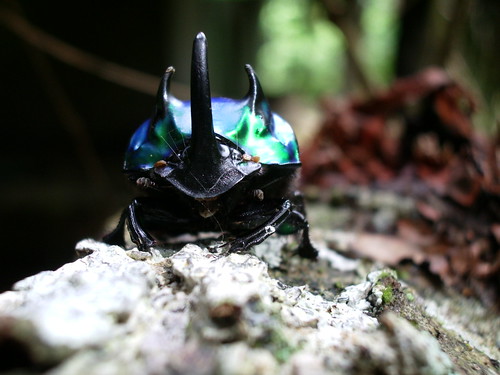 Scarab beetle
Scarab beetle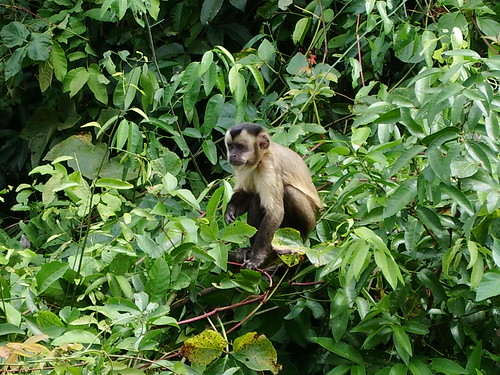 Squirrel Monkey!
Squirrel Monkey!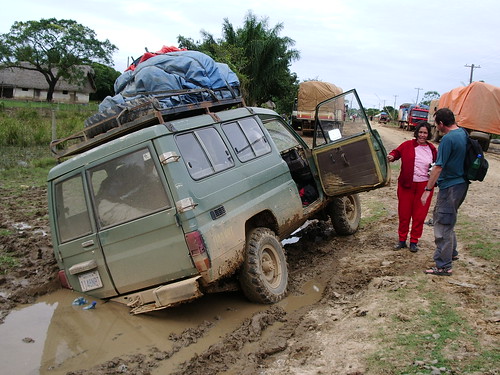 Stuck in da mud
Stuck in da mud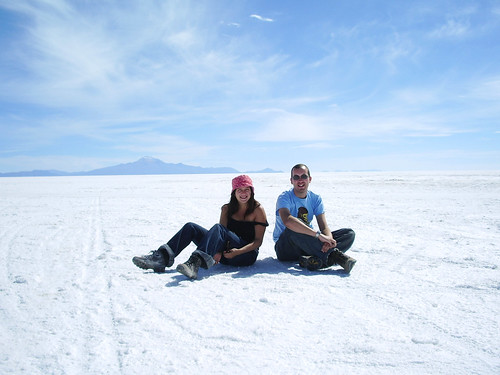 Us on the salt plain
Us on the salt plain